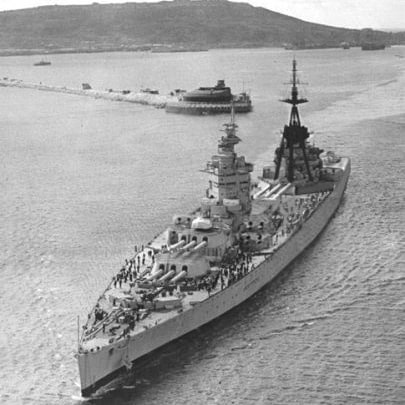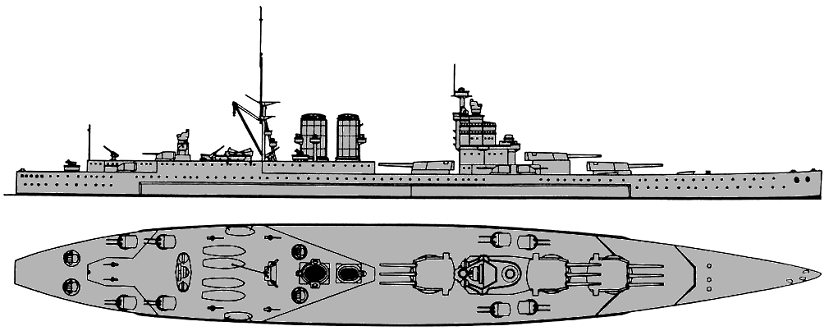
A rendition based on the HMS Nelson in 1947 of what the G-3 would’ve looked like

Please note
I have since made an updated version of this post, this current one is riddled with errors and is completely inaccurate across several measures. This is not my finest work but please see the updated post below:
In light of several suggestions for the iconic Fast Battleships Yamato, Iowa and the proposed H-39 class, I thought i’d make a discussion topic here for the British alternative to these ships that came about 20 years earlier. Britain’s premier battleships Nelson and Vanguard will struggle to compete against such heavy battleships as Yamato and Iowa given that Nelson was essentially worse than Yamato in every regard given her age and Vanguard retains 15 inch guns.
Background
The G-3 Class Battlecruisers were a planned class of 4 Battlecruisers for the Royal Navy in addition to their Half-sister ships the N-3 Class Battleships which were planned to equip the Royal Navy with the premier force of capital ships in the world. Whilst development of the N-3 would be discontinued the G-3 development plowed forwards up until their cancellation following the Washington Naval Treaty.
The G-3 faced months of opposition by the Cabinet and the Treasury whilst the opposition of the Admiralty and notably Winston Churchill pushed forwards as supporters of the class. These ships were to thwart the US plan of building a Navy second to none and to reinforce Britain’s place as the world’s premier naval force. The G-3 alone would have been the highest displacing Battlecruiser ever created out displacing even the mighty Yamato and Iowa class although the German H-39 would go on to out-displace the G-3. Equally G-3 would’ve been faster than anything but Iowa due to her flat stern which became commonplace post-WW2 due to its speed characteristics.
Specifications
Type: Battlecruiser (Fast Battleship)
Displacement:
48,400 long-tons (Standard)
53.909 long-tons (Deep Load)
Length: 856ft (260.9 m)
Beam: 106ft (32.3)
Draught: 35ft 8in (Deep Load)
Installed power: 160,000shp (120,000kW)
Propulsion: 4 shafts; 4 geared steam turbines
Speed: 32-32.5 knots
Range: 7,000 nautical miles at 16 knots
Crew complement: 1,716
Armament:
- 3 × triple 16 in (406 mm) guns
- 8 × twin 6 in (152 mm) guns
- 6 × single 4.7-inch (120 mm)
- 4 × 8-barrel 2-pdr (40 mm (1.6 in)) mountings
- 2 × 24.5-inch (622 mm) torpedo tubes
Armour:
- Belt: 12–14 in (305–356 mm)
- Deck: 3–8 in (76–203 mm)
- Barbettes: 11–14 in (279–356 mm)
- Turrets: 8–17.5 in (203–444 mm)
- Conning tower: 8 in (203 mm)
- Bulkheads: 10–12 in (254–305 mm)

Design Shortcomings
Given the age of the design it would not be fitted with the AA complement that other ships would have, the G-3 whilst not helpless, would not have fared well against aircraft, given only the 40mm’s and 4.7 inch guns were capable of engaging aircraft.
Construction
The G-3 class would be an interesting addition to war thunder in that the truth of its existence is fiercely debated. There are no primary sources proving the class was laid down such as is the case of the German H-39 class of which there are pictures. Many tertiary sources repeat the wikipedia assertion which needs citation stating that the class was never laid down. However based on an understanding of the political climate just weeks before the Washington Naval Treaty and the imperial treasury, there is evidence to suggest it was in fact laid down.
The G-3 class faced opposition post war as the admiralty had their budget more than halved and the treasury urged them to cut down the capital ship numbers in addition to forbidding the construction (but not development) of any new capital ships. Skipping forward a lot of bureaucracy the rumour that there was a disarmament preposition coming up began to come up following the US’ hard plunge into the depression. This was the Washington Naval Treaty.
The only problem facing the UK with this much revered economic break was the current US and Japanese ships under construction would outclass pretty much anything the Royal Navy fielded outside the Hood. To ensure that these ships would be scrapped and discontinued the G-3 class was retrieved from the backburner. Using Admiralty and Imperial funds to finance the ship, the process was rushed just weeks before the Washington Naval Treaty with funds being pulled by the Admiralty and the contract for the ordering of the class of 4 G-3 class Battlecruisers was signed. There is no photographic evidence that the ship was laid down- Laying down is Gaijin’s burden of reality for naval forces in war thunder.
However strong evidence to suggest it was, is that the G-3 class was included in the 1921 Naval Budget and unlike US procurement, ships were purchased and generally considered done-deals. Furthermore the money was indeed pulled, an amount of 2.2 million pounds from the Imperial Dominions and further £15 million from the admiralty itself. Contracts were awarded to the shipyards of John Brown, Swan Hunter and Fairfield on 24 October, and William Beardmore & Co on 1 November. The talks of the Disarmament Treaty began on the 12th of November. Work at John Brown is confirmed to have been done on the keel blocks specifically for this ship class. Given the fact that funds were allocated, materials for the keels purchased, the ships appeared in the defense review and both the US and Japan were satisfied that the ships had in fact been laid down (at least one of them anyway), and given the lack of any primary or secondary sources which say otherwise, I’d say the strongest source is this one: The story behind Britain’s ‘G3’ class battlecruisers - Navy General Board which suggests they were in fact laid down.
And to finally add onto that the Official Battleship New Jersey youtube channel refers to the ships as ‘Barely laid down’.
The controversy as to whether this ship was laid down is why I have refrained from posting this as a suggestion, perhaps closer to the time of other such ships I will suggest this one along with the Lion-class in their proposed 1944 refit.
